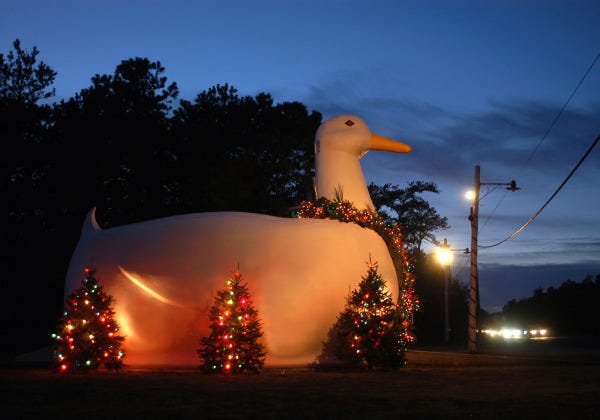World's Largest

Get Indy Film Fest showtimes for this film by clicking here.
This documentary feature takes a look at dying small towns who hatch onto building novelty behemoths to boost their fortunes. Filmmakers Elizabeth Donius and Amy Elliott spent years roaming the country, photographing artificial oversized fruit and fish and interviewing locals who brag about having the world's largest this or that.
It starts out as a funny look at quirky characters and oddball statues, and slowly reveals itself as a wistful commentary about a pastoral community that is ebbing away.
We've all been driving down the highway and seen a billboard for the "World's Largest Cucumber" or some such thing. It's an enticement to pull off the road, snap a picture of the man-made oddity, and hopefully drop a few bucks while you're in town.
Take Strawberry Point, Iowa, for instance. They built a huge strawberry outside the chamber of commerce, which is surrounded by an empty row of storefronts desolated by a long economic slide. The townsfolk have also decorated all over with paintings of strawberries -- none of which has halted the city's fiscal erosion.
There's competition between cities. In Minnesota, one town got a huge boost from their Paul Bunyan statue, so nearby cities copycatted their own version -- adding qualifiers such as "world's largest talking Paul Bunyan" and so forth.
There's even rivalry when one town builds a larger thingamajig, and insists that the older exhibit cease using the "world's largest" description. The strawberry folks, for example, refuse to relinquish their claim on the basis that the competitor's oversized fruit is actually a water tower and not a "natural" strawberry shape like their fiberglass one.
Some towns desperate for attention even turn negatives into a "world's largest." Hidalgo, Texas, had the first outbreak of African killer bees in the U.S., so darned if they didn't erect a monument to killer bees. A clueless local official insists it's a great thing, even though an 80-year-old man recently died from being stung.
There's oversized catfish, an albino buffalo, and even a huge boll weevil. Some of the displays go over the top from merely strange to borderline offensive, as in Odessa's large bunny decorated with a mural of the Twin Towers aflame.
The doc is definitely having fun with hicks from the sticks, and some of the subjects assist enthusiastically: A Lemon Grove woman is so ludicrously theatrical in her mannerisms, she proves divas grow even in the farmland.
But Elliott and Donius aren't looking down on their subjects. Their camera reveals men and women, most of them getting on in years, who are genuinely proud of where they're from and dismayed that the younger folks all seem to be moving away. Their attempts to erect silly monuments to help recapture the glory days may sometimes be pathetic, but they also have a plaintive quality that's truly touching.
"I think every little town needs something special, don't you?" one man asks.
Even as the story wanders all over the land, the cameras keep returning to Soap Lake, Washington. The home to one of the largest mineral lakes in the world, it was once a thriving hub centered around the supposed healing powers of its waters. Now a local fellow named Brent has hatched the idea to put a 65-foot-tall lava lamp in the middle of town.
What the icon of 1960s freak-outs has to do with Soap Lake is a mystery, but Brent's single-minded pursuit manages to generate a lot of enthusiasm amongst the city leaders. Even as the months and years roll by and nothing much happens, it's still the hot topic in town. It ignites the flames of civic passion that have laid dormant for decades.
The film captures an angry debate between Brent and a cantankerous old-timer who demands to know how the poorest town in the state can spend money on this boondoggle when many residents struggle to buy food. Brent insists, delusionally, that the closed storefronts will reopen and jobs will come flooding back if they build the monstrous thing.
That's the essence of the true journey of "World's Largest," as it explores the continental divide between young and old, past and present and a landscape that is slowly being transformed -- one gaudy, gargantuan vegetable at a time.
4 Yaps



